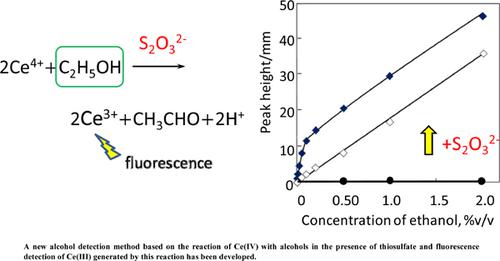Current Analytical Chemistry ( IF 1.7 ) Pub Date : 2021-09-30 , DOI: 10.2174/1573411016999201110094656 Ikko Mikami 1 , Eri Shibayama 1 , Kengo Takagi 1

|
Background: Determination of a reducing substance based on the reaction between Ce(IV) and a reducing substance and fluorescence detection of Ce(III) generated has been reported as a selective and sensitive method. However, this method could not be applied to the determination of alcohol due to the low reaction rate of alcohol and Ce(IV).
Objective: We found that thiosulfate catalytically enhanced the reaction of alcohols (such as, methanol, ethanol, and propanol) and Ce(IV). Utilizing this effect, we developed a new method for the determination of alcohols.
Methods: Alcohols were detected using the reaction of Ce(IV) with alcohols in the presence of thiosulfate and fluorescence detection of the Ce(III) generated by the reaction.
Results: In the presence of thiosulfate, an increase in fluorescence intensity was detected by injecting alcohol at concentrations of several millimolar, whereas it was not observed even at the concentration of 10% v/v (2 M for ethanol) in the absence of thiosulfate. The optimum detection conditions were determined to be 4.0 mM Ce(IV) sulfate and 0.50 mM thiosulfate, and the detection limit (S/N = 3) of ethanol under these conditions was 1 mM. In the calibration curves, changes in the slope were observed when the alcohol concentrations were approximately 10–25 mM. Using a thiosulfate solution containing ethanol as the reaction solution, a calibration curve without any change in slope was obtained, although the concentration of ethanol at the detection limit increased. The alcohols in the liquor and fuel were successfully analyzed using the proposed detection method as a postcolumn reaction.
Conclusion: This new alcohol detection method using a versatile fluorescence detector can be applied to the postcolumn reaction of HPLC omitting need of time-consuming pretreatment processes.
中文翻译:

基于硫代硫酸盐催化醇与铈(IV)反应和铈(III)荧光检测的柱后衍生高效液相色谱法测定醇
背景:据报道,基于 Ce(IV) 与还原性物质之间的反应以及生成的 Ce(III) 的荧光检测来测定还原性物质是一种选择性和灵敏的方法。但由于醇与Ce(IV)的反应速率较低,该方法不适用于醇的测定。
目的:我们发现硫代硫酸盐催化促进醇类(如甲醇、乙醇和丙醇)和 Ce(IV) 的反应。利用这一效应,我们开发了一种测定酒精的新方法。
方法:在硫代硫酸盐存在下,使用 Ce(IV) 与醇的反应检测醇,并对反应产生的 Ce(III) 进行荧光检测。
结果:在硫代硫酸盐存在的情况下,通过注入几毫摩尔浓度的酒精检测到荧光强度的增加,而在没有硫代硫酸盐的情况下,即使在 10% v/v(乙醇为 2 M)的浓度下也没有观察到荧光强度的增加. 最佳检测条件确定为 4.0 mM Ce(IV) 硫酸盐和 0.50 mM 硫代硫酸盐,这些条件下乙醇的检测限 (S/N = 3) 为 1 mM。在校准曲线中,当酒精浓度约为 10-25 mM 时,可以观察到斜率的变化。使用含有乙醇的硫代硫酸盐溶液作为反应溶液,得到了斜率没有任何变化的校准曲线,尽管乙醇在检测极限处的浓度增加了。
结论:这种使用多功能荧光检测器的新酒精检测方法可应用于 HPLC 的柱后反应,无需耗时的预处理过程。









































 京公网安备 11010802027423号
京公网安备 11010802027423号